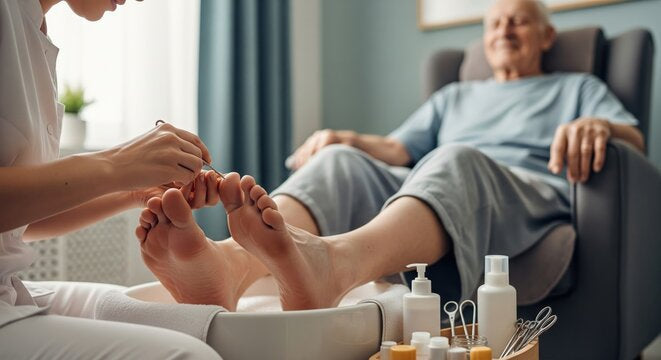
Foot Care Tips for Seniors: Stay Active & Pain-Free at Every Step
Share
Foot Care Tips for Seniors: Stay Active Without Pain 😃👣
Introduction
Aging feet go through changes—thinner skin, reduced fat padding, less elasticity, joint stiffness—and these changes can lead to discomfort, pain, or reduced mobility. But foot pain doesn’t have to be a barrier to staying active. As a board-certified podiatrist, I believe with the right practices, seniors can maintain strong, healthy feet and enjoy daily activities with comfort.
Common Issues in Senior Feet
Here are foot problems that commonly come with age:
-
Dry, cracked skin and heels due to reduced natural oils and skin elasticity.
-
Fat pad atrophy (thinning of cushioning under the soles) which increases pressure on bones and joints when walking.
- Foot deformities such as bunions, hammertoes, or arthritic changes causing joint pain and alignment issues.
-
Nail problems: thickened nails, ingrown toenails, or fungal infections. Keeping the nails trimmed and clean becomes increasingly difficult.
-
Reduced circulation with increased swelling, and higher risk of sores, especially in people with diabetes or vascular issues.
Foot Care Tips for Seniors: How to Stay Active & Pain-Free
Here are practical, safe tips to care for senior feet 👇
1. Daily Foot Inspection & Hygiene
- Look for redness, swelling, blisters, cuts or sores. Early detection prevents complications.
- Wash your feet with warm (not hot) water and mild soap. Dry fully, especially between toes.
2. Moisturizing & Skin Care
- Apply a good moisturizer or foot balm to keep skin supple. Avoid applying lotion between toes to reduce risk of fungal growth.
- Attend to cracked heels promptly with gentle exfoliation and thicker creams.
3. Toenail Care
- Trim toenails straight across and file edges. Be cautious if nails are thickened.
- If it’s difficult to reach your toes (due to flexibility or mobility), consider help from a podiatrist.
4. Footwear Choices
- Shoes should be well-fitting (length, width), roomy in toe box, firm heel support, and cushioned sole.
- Avoid slippers with no support; even indoors, supportive footwear or good socks matter.
- Use shoes with non-slip soles to reduce risk of falls.
5. Support & Padding
- Use cushioned insoles or metatarsal pads if foot pain or fat pad thinning is present.
- Foot pads or soft liners in shoes help reduce pressure on sensitive areas.
6. Gentle Exercises & Stretching
- Toe curls, ankle circles, calf stretches to maintain flexibility and strengthen foot/ankle muscles.
- Walking, seated foot exercises help stimulate circulation.
7. Manage Swelling & Circulation
- Elevate feet whenever possible.
- Wear compression socks or support stockings if swelling is frequent (but check with doctor if circulation problems exist).
8. Regular Check-ups & Professional Care
- Visit a podiatrist annually (or more often if you have diabetes, arthritis, or circulation issues).
- Watch for persistent pain, changes in foot shape, numbness, or open sores.
Lifestyle Habits that Support Foot Health
- Maintain a healthy weight to reduce pressure on feet.
- Hydrate well; good nutrition supports skin health.
- Maintain mobility and balance to prevent falls (activities like gentle yoga, tai chi, or balance exercises).
- Avoid smoking—it impairs circulation and slows healing.
Final Thoughts
Feet carry you through life; as we age, they deserve our attention and care. By inspecting, moisturizing, choosing safe footwear, doing gentle exercises, and getting professional checks, seniors can keep feet strong, mobile, and free from pain. At PodiatryMarket.com, our mission is to help you walk comfortably through all your golden years.
Stay active, stay supported, and love your feet every day! 💙
Dr. Ahmad Rashid, DPM
Board-Certified Podiatrist & Founder, PodiatryMarket.com
Disclaimer: This post is educational and not intended as a substitute for medical advice. Consult your healthcare professional for personalized recommendations.
